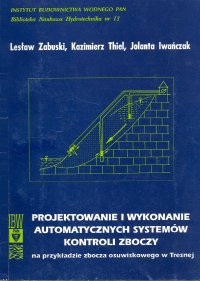Books
 Zabuski L., Thiel K., Iwańczak J.
Zabuski L., Thiel K., Iwańczak J.
Projektowanie i wykonanie automatycznych systemów kontroli zboczy na przykładzie zbocza osuwiskowego w Tresnej
publisher: Wydawnictwo IBW PAN
ISBN: 8385708022
published in: 1992
language: pl
Summary:
Formation of water reservoirs in the mountain regions is a frequent reason of activation of old or development of new landslides on the embankment slopes. Such landslides are unfavourable and in some cases dangerous phenomena. Therefore their registration, observation and forecasting is the matter of the great importance. These activities are carried out using many different methods and means. The most simple is a general periodic inspection of the reservoir embankments. In some cases very sophisticated observations should be carried out, in which specialized measurement equipment is installed, which forms the monitoring system.
Such system, installed on the landslide slope in Tresna near Żywiec is described in the study. The slope is situated on the embankment of Żywieckie Lake – artificial reservoir formed in 1966 on Soła River after construction of Tresna Dam. There was an old landslide on the slope, which was reactivated due to reservoir filling. The monitoring system, named ASKOT was designed and installed on the slope in 1986-90.
The subject of the study is the description of the problems, which concern ASKOT installation. The problems presented can be divided into three groups. In the first group general considerations regarding the needs, objectives and methods of the slope monitoring are presented. ASKOT is a first system installed in Poland, thus such considerations are necessary. The second group contains the results of interdisciplinary investigations and measurements (e.g. geology, geotechnics, geophysics, displacement measurements, etc.), carried out before and during the installation of the system. The third group concerns the structure and construction of ASKOT.
The slope inclined at 14 degrees is formed of typical Carpathian flysch rocks – i.e. sequentially lying beds of sandstone and clay shale. The slides of the rock mass are observed at different depths in the shales. Slide surfaces were detected using different methods. The inclinometric measurements were recognized as most efficient and accurate, as they allow to find any slide surface which is contemporary active. It was stated that the main reasons, determining slide movement are the fluctuations of the underground water table (GWL) in the slope and changes the water level in the reservoir. These phenomena are strongly related with precipitations. These dependencies are discussed in the study.
ASKOT was designed and installed basing on the general principles, given in the first group. The results of the former investigations and measurements were also taken into account. It can be described as “cause-effect” system, i.e. the system, which records the quantities influencing the state of the slope (GWL, water level in the reservoir) and being the causes of its instability and the quantities which are the attribute (effect) of instability (slope deformations). The piezometric gauges were installed in the boreholes on the slope, to record the GWL, whereas the displacements were measured by fixed-in-place borehole inclinometers, located at the depths of the active slide surfaces. The limit values were determined, i.e. maximum admissible values for the quantities measured. It was assumed that the critical state of the slope is reached if the value of some quantity reaches or exceeds the limit value.
The gauges arranged on the slope are electrically connected with the measurement centre. The principal part of this centre is the measuring unit, automatically connected with the gauges in time of the measurement action. Both the gauges and the unit act on the principle of the vibrating wire. The remote control of the measurements is provided using microcomputer which is logically connected by the interface to the measurement unit, so the later “understands” the signals from the microcomputer and record the results as well as “translates” them into physical quantities. The ASKOT structure could be modified, e.g. by adding the new gauges or installing the alarm set, etc.
The study gives some contribution to the recognition of the landslide processes in the nearest vicinity of the water reservoirs as well as it gives some practical and theoretic aims, which possibly could help to install the systems allowing to monitor the state of the slopes.
